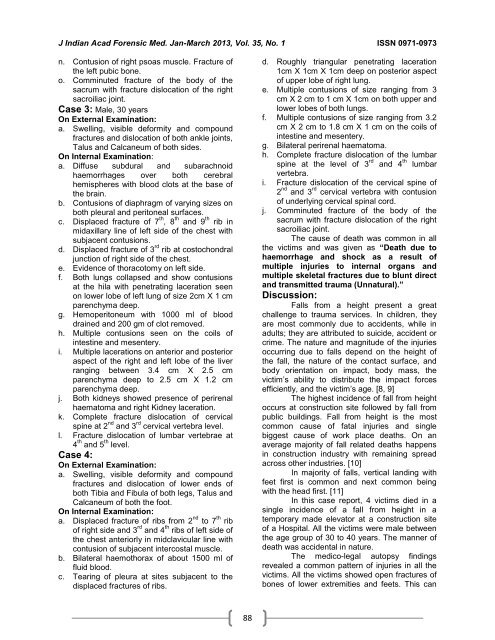jiafm-35-1 - forensic medicine
jiafm-35-1 - forensic medicine
jiafm-35-1 - forensic medicine
Create successful ePaper yourself
Turn your PDF publications into a flip-book with our unique Google optimized e-Paper software.
J Indian Acad Forensic Med. Jan-March 2013, Vol. <strong>35</strong>, No. 1 ISSN 0971-0973<br />
n. Contusion of right psoas muscle. Fracture of<br />
the left pubic bone.<br />
o. Comminuted fracture of the body of the<br />
sacrum with fracture dislocation of the right<br />
sacroiliac joint.<br />
Case 3: Male, 30 years<br />
On External Examination:<br />
a. Swelling, visible deformity and compound<br />
fractures and dislocation of both ankle joints,<br />
Talus and Calcaneum of both sides.<br />
On Internal Examination:<br />
a. Diffuse subdural and subarachnoid<br />
haemorrhages over both cerebral<br />
hemispheres with blood clots at the base of<br />
the brain.<br />
b. Contusions of diaphragm of varying sizes on<br />
both pleural and peritoneal surfaces.<br />
c. Displaced fracture of 7 th , 8 th and 9 th rib in<br />
midaxillary line of left side of the chest with<br />
subjacent contusions.<br />
d. Displaced fracture of 3 rd rib at costochondral<br />
junction of right side of the chest.<br />
e. Evidence of thoracotomy on left side.<br />
f. Both lungs collapsed and show contusions<br />
at the hila with penetrating laceration seen<br />
on lower lobe of left lung of size 2cm X 1 cm<br />
parenchyma deep.<br />
g. Hemoperitoneum with 1000 ml of blood<br />
drained and 200 gm of clot removed.<br />
h. Multiple contusions seen on the coils of<br />
intestine and mesentery.<br />
i. Multiple lacerations on anterior and posterior<br />
aspect of the right and left lobe of the liver<br />
ranging between 3.4 cm X 2.5 cm<br />
parenchyma deep to 2.5 cm X 1.2 cm<br />
parenchyma deep.<br />
j. Both kidneys showed presence of perirenal<br />
haematoma and right Kidney laceration.<br />
k. Complete fracture dislocation of cervical<br />
spine at 2 nd and 3 rd cervical vertebra level.<br />
l. Fracture dislocation of lumbar vertebrae at<br />
4 th and 5 th level.<br />
Case 4:<br />
On External Examination:<br />
a. Swelling, visible deformity and compound<br />
fractures and dislocation of lower ends of<br />
both Tibia and Fibula of both legs, Talus and<br />
Calcaneum of both the foot.<br />
On Internal Examination:<br />
a. Displaced fracture of ribs from 2 nd to 7 th rib<br />
of right side and 3 rd and 4 th ribs of left side of<br />
the chest anteriorly in midclavicular line with<br />
contusion of subjacent intercostal muscle.<br />
b. Bilateral haemothorax of about 1500 ml of<br />
fluid blood.<br />
c. Tearing of pleura at sites subjacent to the<br />
displaced fractures of ribs.<br />
d. Roughly triangular penetrating laceration<br />
1cm X 1cm X 1cm deep on posterior aspect<br />
of upper lobe of right lung.<br />
e. Multiple contusions of size ranging from 3<br />
cm X 2 cm to 1 cm X 1cm on both upper and<br />
lower lobes of both lungs.<br />
f. Multiple contusions of size ranging from 3.2<br />
cm X 2 cm to 1.8 cm X 1 cm on the coils of<br />
intestine and mesentery.<br />
g. Bilateral perirenal haematoma.<br />
h. Complete fracture dislocation of the lumbar<br />
spine at the level of 3 rd and 4 th lumbar<br />
vertebra.<br />
i. Fracture dislocation of the cervical spine of<br />
2 nd and 3 rd cervical vertebra with contusion<br />
of underlying cervical spinal cord.<br />
j. Comminuted fracture of the body of the<br />
sacrum with fracture dislocation of the right<br />
sacroiliac joint.<br />
The cause of death was common in all<br />
the victims and was given as “Death due to<br />
haemorrhage and shock as a result of<br />
multiple injuries to internal organs and<br />
multiple skeletal fractures due to blunt direct<br />
and transmitted trauma (Unnatural).”<br />
Discussion:<br />
Falls from a height present a great<br />
challenge to trauma services. In children, they<br />
are most commonly due to accidents, while in<br />
adults; they are attributed to suicide, accident or<br />
crime. The nature and magnitude of the injuries<br />
occurring due to falls depend on the height of<br />
the fall, the nature of the contact surface, and<br />
body orientation on impact, body mass, the<br />
victim’s ability to distribute the impact forces<br />
efficiently, and the victim’s age. [8, 9]<br />
The highest incidence of fall from height<br />
occurs at construction site followed by fall from<br />
public buildings. Fall from height is the most<br />
common cause of fatal injuries and single<br />
biggest cause of work place deaths. On an<br />
average majority of fall related deaths happens<br />
in construction industry with remaining spread<br />
across other industries. [10]<br />
In majority of falls, vertical landing with<br />
feet first is common and next common being<br />
with the head first. [11]<br />
In this case report, 4 victims died in a<br />
single incidence of a fall from height in a<br />
temporary made elevator at a construction site<br />
of a Hospital. All the victims were male between<br />
the age group of 30 to 40 years. The manner of<br />
death was accidental in nature.<br />
The medico-legal autopsy findings<br />
revealed a common pattern of injuries in all the<br />
victims. All the victims showed open fractures of<br />
bones of lower extremities and feets. This can<br />
88




![syllabus in forensic medicine for m.b.b.s. students in india [pdf]](https://img.yumpu.com/48405011/1/190x245/syllabus-in-forensic-medicine-for-mbbs-students-in-india-pdf.jpg?quality=85)



![SPOTTING IN FORENSIC MEDICINE [pdf]](https://img.yumpu.com/45856557/1/190x245/spotting-in-forensic-medicine-pdf.jpg?quality=85)

![JAFM-33-2, April-June, 2011 [PDF] - forensic medicine](https://img.yumpu.com/43461356/1/190x245/jafm-33-2-april-june-2011-pdf-forensic-medicine.jpg?quality=85)


![JIAFM-33-4, October-December, 2011 [PDF] - forensic medicine](https://img.yumpu.com/31013278/1/190x245/jiafm-33-4-october-december-2011-pdf-forensic-medicine.jpg?quality=85)


